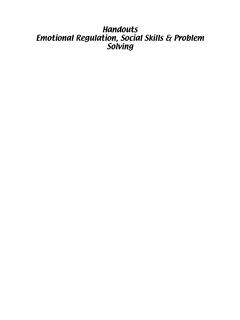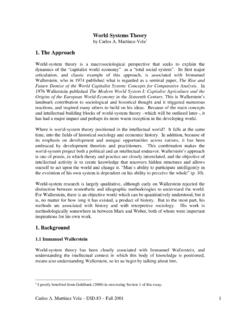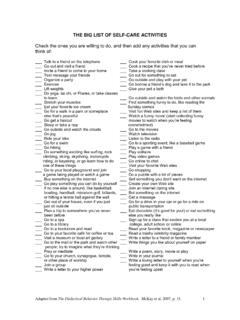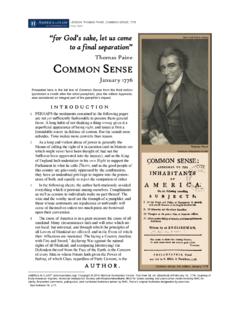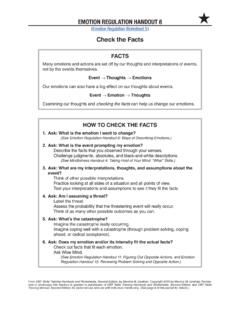Transcription of Dialectical Behavior Therapy
1 Dialectical Behavior Therapy (DBT) Manual Table of Contents SECTION 1 Orientation3 SECTION 2 Mindfulness13 SECTION 3 Distress Tolerance33 SECTION 4 Middle Path79 SECTION 5 Emotion Regulation 103 SECTION 6 Interpersonal Effectiveness159 SECTION 7 Addendum183 Not All Who Wander Are Dialectical Behavior TherapyOrientation(DBT)3 DBT is an effective treatment for people who have difficulty controlling theiremotions and behaviors. DBT aims to replace problem behaviors with skillful behaviors. DBT skills help people experience a range of emotions without necessarilyacting on those emotions. DBT skills help teens & families navigate relationships in their environment(relationships/school/work/pe ers).
2 DBT helps people create a life worth Does Dialectical Mean? Dialectical = two opposite ideas can be true at the same time, and when considered together, can create a new truth and a new way of viewing the situation. There is always more than one way to think about a Is Dialectical Behavior Therapy (DBT)?4 PERSONAL GOALS:Behaviors to Increase1. Behaviors to decrease 1. 2. 2. 3. 3. 4. 4. 5. 5. Goals of Skills TrainingTarget Behavior DBT Skill Confusion About Yourself: Feelings of emptiness, not knowing what you feel or why you get upset; trouble making or holding to decisions Mindfulness: Awareness to thoughts, emotions, Without adding or subtracting Impulsivity: Acting without thinking it all the way through; alcohol or drug use; anger reactions; suicidal or self-destruction Distress Tolerance: Tolerating stress and not making it worse; accepting reality as it is Emotional Instability: Fast, intense mood changes with little control; steady, negative emotional state; Extreme mood swings & sensitivity Emotional Regulation: Control of emotions.
3 Reduce vulnerabilities; Change negative emotions Interpersonal Problems: Difficulty keeping steady relationships, getting what you want, or keeping self-respect; efforts to avoid rejection or feelings of abandonment Interpersonal Effectiveness: Deal with conflicts; increase self-respect; get what you want; say no assertively All Or Nothing Thinking: Things are either good or bad, fair or unfair; polarized thinking, feeling, or acting; always wanting to be right Walking The Middle Path: Be willing to negotiate; see all perspectives; live in gray 5 Options for Solving any ProblemWhen life presents you with problems, what are your options? The PrOBlemChange the situation.
4 Or avoid, leave, or get out of the situation BeTTer aBOuT The PrOBlemChange (or regulate) your emotional response to the The PrOBlemAccept and tolerate both the problem and your response to the miSeraBleOr possibly make it worse! PrOBlem-SOlve:Use interpersonal effectiveness skillsWalking the Middle Path (from interpersonal effectiveness skills)Use problem- solving skills (from emotion regulation skills) feel BeTTer aBOuT The PrOBlem:Use emotion regulation TOleraTe The PrOBlem:Use distress tolerance and mindfulness STay miSeraBle:Use no skills!6 Pros and cons of using SkillsDue Date: Name: Week Starting: Use this worksheet to figure out the advantages and disadvantages to you of using skills ( , acting skillfully) to reach your goals.
5 The idea here is to figure out what is the most effective way for you to get what you want in life. Remember, this is about your goals, not someone else s the situation or problem:Describe your goal in this situation:Make a list of the Pros and Cons of practicing your skills in this another list of the Pros and Cons for not practicing your skills or of not practicing them the facts to be sure that you are correct in your assessment of advantages and on the back if you need more Skillsnot Practicing SkillscOnSPracticing Skillsnot Practicing SkillsWhat did you decide to do in this situation? is this the best decision (in Wise mind)? 7 is a biological vulnerability to return to inability to effectively regulate WITH.
6 SOCIAL:An invalidating environment communicates that what you are feeling, thinking, or doing doesn t make sense or is considered inaccurate or an overreaction. Environments include parents, teachers, peers, therapists, coaches, and others. Sometimes there is a poor fit ( , temperament) between the person and the invalidating environment punishes or sometimes reinforces emotional displays and contributes to the person s suppression or escalation of emotions, and sometimes leaves the person feeling confused and unable to trust one s own emotional experiences (self-invalidation).OVER TIME LEADS TO .. Multiple Problems (Chronic Emotional Dysregulation)Biosocial Theory 8 Biosocial TheoryWhy do i have so much trouble controlling my emotions and my actions?
7 Emotional vulnerability is BiOlOGical: it s simply how some people are born. They are more sensitive to emotional stimuli; they can detect subtleemotional information in the environment that others don t even notice. They experience emotions much more often than others. Their emotions seem to hit for no reason, from out of the blue. They have more intense emotions. Their emotions hit like a ton of bricks. And their emotions are long- also has a BiOlOGical basis: regulating action is harder for some than for others. They find it very hard to restrain impulsive behaviors. Often, without thinking, they do things that get them in trouble. Sometimes their Behavior seems to come out of nowhere.
8 They find it very hard to be effective. Their moods get in the way of organizing to achieve their goals. They cannot control behaviors linked to their invalidating SOcial environment can make it very hard to regulate emotions. An invalidating environment doesn t seem to understand your emotions. It tells you your emotions are invalid, weird, wrong, or bad. It often ignores your emotional reactions and does nothing to help you. It may say things like Don t be such a baby! Quit your blubbering. Quitbeing such a chicken and just solve the problem. or Normal people don tget this frustrated. People who invalidate are OfTen DOinG The BeST They can. They may not know how to validate or how important it is to validate, orthey may be afraid that if they validate your emotions, you will get moreemotional, not less.
9 They may be under high stress or time pressure, or they may have toofew resources themselves. There may be just a poor fit between you and your social environment:you may be a tulip in a rose ineffective SOcial environment is a big problem when you want to learn to regulate emotions and actions. Your environment may reinforce out-of- control emotions and actions. If people give in when you get out of control, it will be hard for you to get incontrol. If others command you to change, but don t coach you on how to do this,it will be hard to keep on trying to s the TranSacTiOnS that count between the person and the social environment. Biology and the social environment influence the person.
10 The person reciprocates and influences his or her social environment. The social environment reciprocates and influences the person. And so on and on and on. obtained during sessions (including the names of other groupmembers) must remain in group support each other names and information every effort to practice skills between each other, avoid judging each other, and assume the best abouteach helpful, noncritical feedback when willing to accept help from a person they are not to discuss any risk behaviors with other group members outsideof sessions. Participants do not tempt others to engage in problem may not act in a mean or disrespectful manner toward other groupmembers or teens in a comprehensive DBT program, each adolescent must be inongoing individual DBT for the Adolescent Skills Training Group are doing the best they can.




